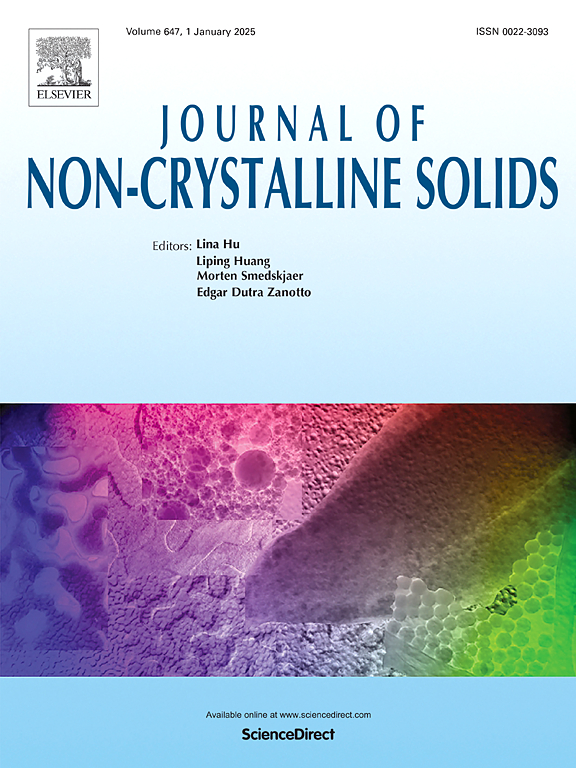Effect of La2O3 on structure and chemical strengthening properties of Li2O–Al2O3–SiO2 glass: experiment and simulation
IF 3.5
3区 材料科学
Q1 MATERIALS SCIENCE, CERAMICS
引用次数: 0
Abstract
This study systematically investigates the regulatory effect of La2O3 on the structure, mechanical and chemical strengthening properties of lithium aluminosilicate (LAS) glass through experiment and molecular dynamics (MD) simulation. MD simulations demonstrate that La2O3 incorporation enhances network densification through the high field strength of La³⁺ (Z/r²=2.82). The main coordination number (CN) of La atoms is 6, which dynamically changes to 5∼8 with the increase of content, and the bond length of La-O is shortened from 2.24 Å to 2.21 Å and then increased to 2.31 Å. When adding 1.0 mol % La2O3, the Vickers hardness and bending strength of glass are as high as 7.15 GPa and 205 MPa, respectively. However, the excessive La2O3 (>1.0 mol %) destroys the connectivity of [SiO4] network and reduces the proportion of Q⁴. With the increase of La2O3 content, the chemical strengthening results show that the surface compressive stress decreases linearly. In contrast, the depth of the stress layer (DOL) decreased first and then increased, attributed to the “densification-depolymerization” competition mechanism of La2O3 in LAS glass. Results provide the theoretical guidance for development of LAS glass containing rare earth oxides that have highly effective chemical strengthening properties.

La2O3对Li2O-Al2O3-SiO2玻璃结构及化学强化性能的影响:实验与模拟
通过实验和分子动力学(MD)模拟,系统研究了La2O3对硅酸铝锂(LAS)玻璃的结构、力学和化学强化性能的调控作用。MD模拟表明,La2O3的掺入通过La³+ (Z/r²=2.82)的高场强增强了网络致密性。La原子的主配位数(CN)为6,随含量的增加而动态变化为5 ~ 8,La- o的键长由2.24 Å缩短到2.21 Å,再增加到2.31 Å。当加入1.0 mol % La2O3时,玻璃的维氏硬度和抗弯强度分别高达7.15 GPa和205 MPa。然而,过量的La2O3 (>1.0 mol %)破坏了[SiO4]网络的连连性,降低了Q⁴的比例。化学强化结果表明,随着La2O3含量的增加,表面压应力呈线性减小趋势。而应力层深度(DOL)先减小后增大,这是由于La2O3在LAS玻璃中的“致密-解聚”竞争机制所致。研究结果为开发具有高效化学强化性能的稀土氧化物LAS玻璃提供了理论指导。
本文章由计算机程序翻译,如有差异,请以英文原文为准。
求助全文
约1分钟内获得全文
求助全文
来源期刊

Journal of Non-crystalline Solids
工程技术-材料科学:硅酸盐
CiteScore
6.50
自引率
11.40%
发文量
576
审稿时长
35 days
期刊介绍:
The Journal of Non-Crystalline Solids publishes review articles, research papers, and Letters to the Editor on amorphous and glassy materials, including inorganic, organic, polymeric, hybrid and metallic systems. Papers on partially glassy materials, such as glass-ceramics and glass-matrix composites, and papers involving the liquid state are also included in so far as the properties of the liquid are relevant for the formation of the solid.
In all cases the papers must demonstrate both novelty and importance to the field, by way of significant advances in understanding or application of non-crystalline solids; in the case of Letters, a compelling case must also be made for expedited handling.
 求助内容:
求助内容: 应助结果提醒方式:
应助结果提醒方式:


